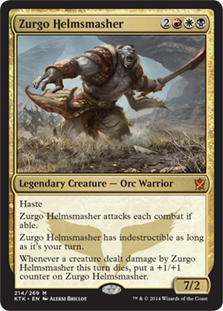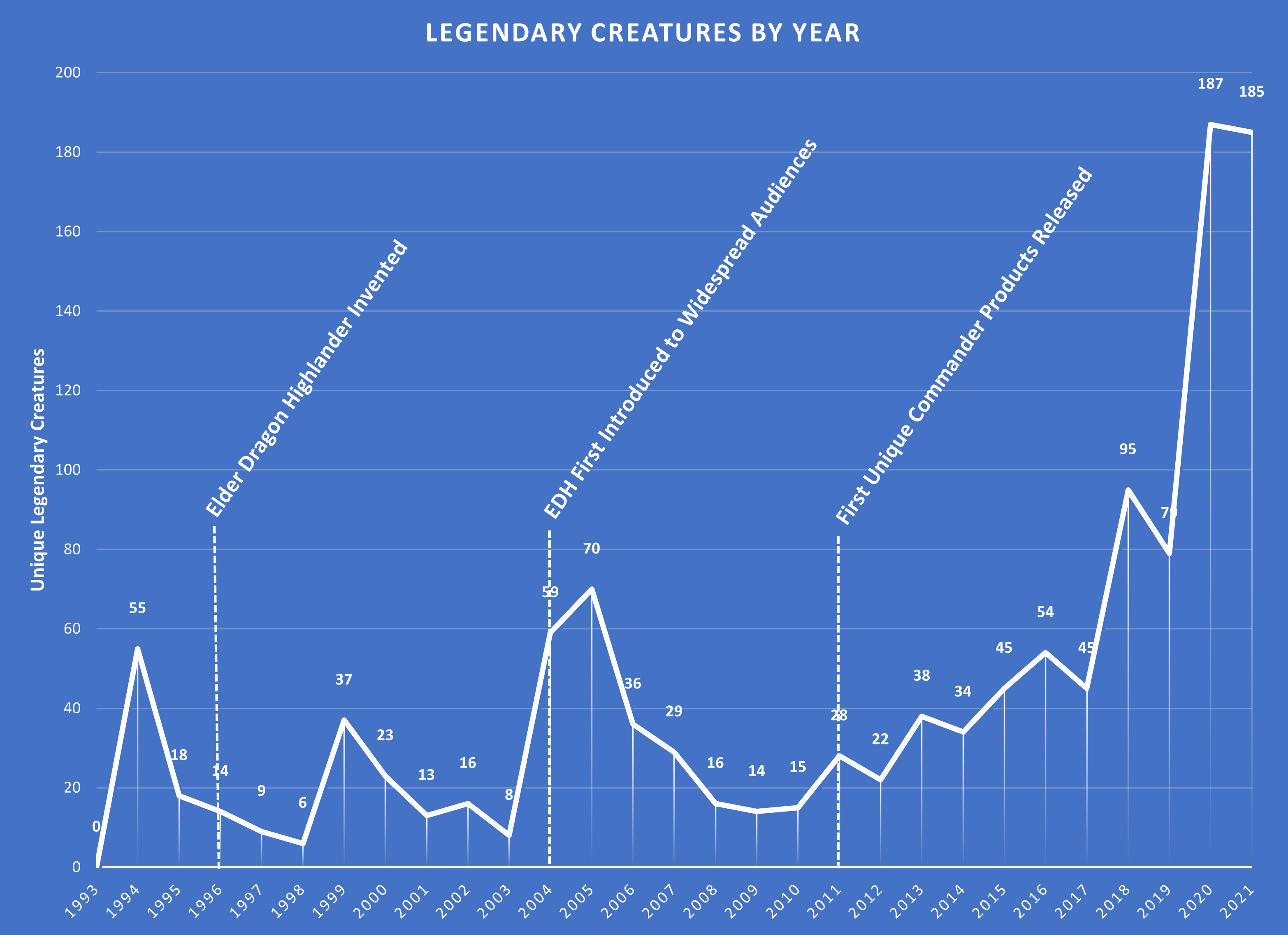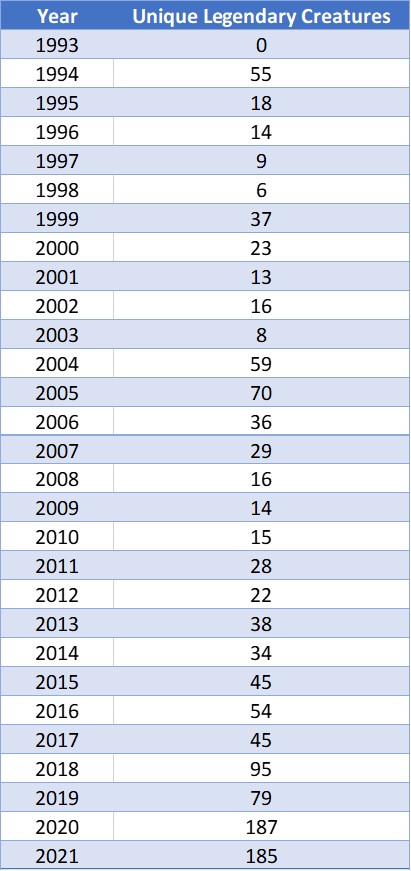What would you say if I told you that 30% of all new legendary creatures in Magic: the Gathering have been printed in the last two years?
Surely that could not be the case, especially as the game enters its 29th year in existence. That wouldn’t make much logical sense. With its ever-growing spread of fanciful and canonical heroes across myriad planes of wizarding lore, clearly such a statistic would be implausible; we would have a much more even distribution over its tenure…right?
Outwardly it’s not an irrational train of thought, especially were it to come from an outside perspective or that of former/lax players who haven’t really paid attention to such things.
Nevertheless, that indeed is very much the case. Even discounting Theros Beyond Death, which had the luxury of releasing in 2020 just prior to the world going to hell, the remaining legendary creatures to come out since then still means 27.6% of all unique legendary creatures in existence have come out during the pandemic era. Which either means we’ve been stuck in a COVID-fueled time loop nightmare for decades, or several years back Wizards decided there was such an insatiable appetite for legendary creatures that they could strap us down, turn the spigot from Steady Drip to Fire Hose, and we’d reward them for doing so rather than complain about being able to keep up with it all.
Probably both. I’m betting it’s both.
This rather drastic change is best suited by just pointing to the raw numbers, denoted here:
This chart lists the number of unique, playable legends to have come out in a purchasable product during a particular calendar year, not counting straight reprints or silver-bordered (now “acorn”) cards. And the numbers are striking.
For the vast majority of Magic’s lifespan, the number of legendary creatures put out have been markedly restrained compared to the overall number of cards. For the game’s first 20 years the median number of legends to come out annually was only around 20 or so, with a few exceptions:
- 1994 saw the instruction of legendary creatures in, well, Legends, and would be the largest single year infusion for nearly a decade.
- 1999 saw a comparatively high output due to the release of Portal Three Kingdoms, which included a lot of named figures from the Three Kingdoms story.
- 2004-2005 was directly a result of the number of legends in the three Kamigawa sets.
- Even while already on a clear upwards trajectory, 2018 saw a huge comparative spike in large part due to a sizable ‘legends matter’ theme in Dominaria, accounting for nearly half of that year’s numbers.
The reason for why these numbers were otherwise modest is pretty simple: until the popularity of Commander took off in earnest around 2013, many designers at Wizards categorically saw legendary status as a flavorful but negative trait and generally reserved for notable characters from the storylines.
This is further reflected in how the legend rule has fluctuated over time. From the Legends set until Ice Age, all legendary creatures were Restricted in Constructed play, meaning you could only have one of them in the deck. Moreover, the “legend rule” from their introduction until the Kamigawa block stated that if anyone managed to get a specific legendary creature on the battlefield that matched one in your hand, yours was essentially useless while the other remained alive, as any new duplicates would immediately die. This led to a lot of frustrating Constructed gameplay at times and to a still-present worry from players about having too many duplicates of the same legend in their deck for fear of it becoming a dead card.
Wizards altered course during the Kamigawa block (for reasons illustrated above) and changed the rule such that if two or more identical legends existed on the battlefield at the same time, they all died, giving more agency to their use as a mirror match effect. This was loosened again in Magic 2014 to the current rule that duplicate legends concerns only apply to individual players; if you end up with two or more of the same legend on the battlefield, you choose which one lives and which dies.
This change also coincided with the continued rapid upward trajectory in popularity of the nascent Commander format as it eventually rose to become the de facto casual Magic format of choice. The last few years in particular have clearly illustrated that Wizards has taken a marked turn in their thinking about legendary creatures, both attempting to feed the endless maw that is player desires for new Commander choices while also trying to cash in on the process.
Whether Wizards is simply meeting the current appetite of the marketplace or if they’ve overstuffed the proverbial menu of late remains to be seen. (Personally I feel they have oversaturated things at a particularly inopportune time.) In either case, for fans of legendary creatures, there has never been a more robust period of variety and options than the last few years.
That all being said, it can get lost on quite a few people that just because a legendary creature can be your Commander, it doesn’t necessarily mean it should. Problematic and ineffectual Commanders aside, there’s also the reality that sometimes a legendary creature can work even better for you as a lieutenant than as a general.
Which is a little ironic for this week’s pick, given that he once was a general.
Awkward.
Today we have: Zurgo Helmsmasher

Name: Zurgo Helmsmasher
Edition: Khans of Tarkir
Rarity: Mythic Rare
Focus: Creature Advantage
Highlights: During the time of the Khans block, Zurgo actually received a fair amount of attention, albeit not necessarily for Commander reasons. For one, his usefulness in Limited was hard to match in terms of lethality and aggressiveness, making him an easy choice to draft.
Yet arguably his most lasting legacy was his character from a story perspective: Zurgo was one of those individuals repeatedly pointed out to demonstrate the revised Khans timeline. In his case he went from a vicious and feared general with a cinematic villain level grudge against Sarkhan to an oft-threatened signal caller for arriving dragons. His character’s interest from players wasn’t just a case of a deserved comeuppance but also an emblematic example of just how much the plane had changed.
From a Commander perspective, however, the card was often treated as something less exhilarating.
This isn’t to say that there hasn’t been a fair amount of people who have made a Zurgo-helmed Commander deck over the years, but given the number of options just in the Khans block alone – a full two dozen legendary creatures – his popularity was never among the top echelons when there were numerous others to choose from even at the time who were more enticing. Anafenza, the Foremost, Dragonlord Dromoka, and Shu Yun, the Silent Tempest all were popular choices, as was Atarka, World Render as a viable dragon Commander. I wrote an entire deck building series chronicling my process of creating a potent but not broken version of Alesha, Who Smiles at Death. I also lamented in a later piece about how many people were taking the inherent build-around fun of Narset, Enlightened Master and utterly breaking her – to everyone’s loss.
Zurgo certainly had fans, but ultimately it was not one that many gravitated towards in the same way. The simple reasoning is that as a Commander, it’s kind of on rails. Zurgo is a massively scary 7/2 for five mana that’s indestructible if it’s your turn and if any creature it damages dies, it gets even bigger. All of that is a marvelous and dangerous combination on the battlefield. He is effective and intimidating, without a doubt.
The problem is, however, twofold.
For one, Zurgo doesn’t enable anything else in the deck; he’s sort of a one-orc show. This is fine to some EDH players but a definite issue to others. Second, and more importantly, Zurgo must attack every turn. This usually means either singling an individual player out and hammering them regardless of whether they can handle the assault, or, conversely spreading the damage around as to avoid picking on one person the entire time and irritate multiple opponents equally. In both cases, most casual Commander play groups can find that sort of early hyper-aggressive behavior – one that you have no control over no less – inherently problematic, as an overly hostile and antagonistic player can end up having the table unify against them.
Essentially, Zurgo as a Commander says you intend to come out swinging and are daring others to stop you. It’s hardly an untouchable creature (it’s both tapped and vulnerable on everyone else’s turn), but it’s not quite conducive to the inviting atmosphere most Commander metas try to foster.
On the other hand, Zurgo as part of your 99 can be much more worthwhile. This way allows you to force players to contend with his appearance without feeling guilty over using it or feeling compelled to immediately cast it again at your next opportunity. At the same time it doesn’t immediately put your opponents on their heels before the game is barely underway. In short, using Zurgo in the 99 is actually more fun. (It also opens up the top slot to one of more than 30 other possible Mardu-capable Commanders out there.)
Just as was mentioned in a past piece with another Khans legend, Surrak Dragonclaw, on how it could benefit from not being a Commander thanks to its surprise factor, so too could Zurgo benefit by being more of an in-deck threat than the one leading the charge. Despite there now being over 1200 unique legendary creatures, no where is it written that every one of them must be destined for Commander status.
Sometimes, as in the case of ol’ angry eyes here, it can actually be more advantageous to avoid the top job and leave the heavy lifting to someone else.
Keep an eye out for us to be regularly featuring other more accessible-but-worth-it Commander cards going forward. In the meantime, we’ll keep the light on for you.
![]()
You can discuss this article over on our social media!


